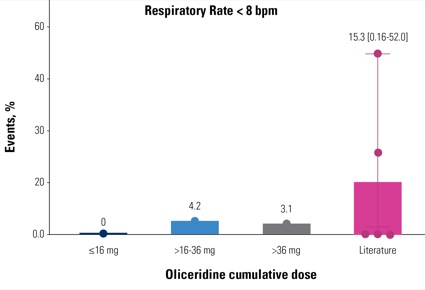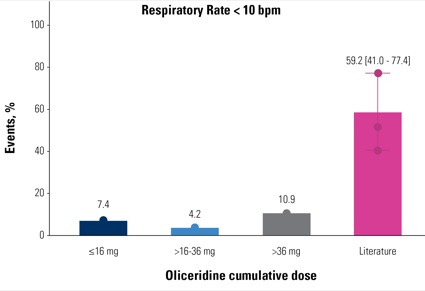Author: Bob Kronemyer
Anesthesiology News
The investigational IV opioid oliceridine (Trevena) provided adequate and rapid analgesia after colorectal surgery, according to a secondary analysis of a subgroup of patients that was part of a phase 3, multicenter, open-label study.
The analysis, which was presented at the 2019 Annual Congress of the American Society for Enhanced Recovery (poster 2), found that oliceridine correlated to a low risk for opioid-induced respiratory depression (OIRD) compared with historical controls.
“Further, the data suggest that older age in patients receiving the drug did not increase the risk for developing OIRD,” said lead author Marek Brzezinski, MD, PhD, a professor of anesthesia at the University of California, San Francisco.
Oliceridine is a G protein–selective agonist at the mu-opioid receptor. “This is important because G protein selectivity results in potent analgesia, with less recruitment of beta-arrestin—a signaling pathway that may lead to adverse events such as respiratory depression,” Dr. Brzezinski said.
None of the 115 cohort patients (mean age, 59.7 years) who underwent colorectal surgery required naloxone, supporting the safety of oliceridine (Figure 1).
Furthermore, in this cohort, the incidence of hypoxia (oxygen saturation <90%) and bradypnea (respiratory rate [RR] <8 or 10 breaths per minute; Figures 2 and 3, respectively) were lower than reported in the literature: Only 2.6% of patients demonstrated a RR below 8, and only 9.6% of patients experienced peripheral capillary oxygen saturation less than 90% (Figure 4).
“Interestingly, none of the cohort patients experienced concurrent hypoxia and bradypnea during oliceridine dosing,” Dr. Brzezinski said.
The low risk for OIRD compared with historical controls using similar definitions of abnormal vital signs “is very encouraging and provides support to study more selective opioids,” said Dr. Brzezinski, noting that the reported incidence of OIRD in the literature can be as high as 50% to 74%.
“We were surprised that the data indicated that patient age was not a risk factor for developing OIRD in patients receiving oliceridine, as age has been one of the known risk factors for OIRD,” Dr. Brzezinski said. “This finding possibly suggests that oliceridine may be safer and hence particularly attractive in the elderly population.”
Nonetheless, like any opioid, oliceridine should be part of multimodal analgesia. “The total oliceridine dose should be kept as low as possible, and the patient should be monitored according to the routine hospital standard for opioids,” Dr. Brzezinski said.
“Our results are timely and encouraging, especially in the context of the ongoing opioid crisis,” Dr. Brzezinski said. “There is an urgent need for opioids with a safer risk profile, particularly in the elderly.”
Larger-Scale Study Needed
The analysis indicates that oliceridine may provide a new treatment option for patients with moderate to severe acute pain, with a potentially improved safety profile compared with other opioids. However, study results need to be confirmed in future studies because the phase 3 ATHENA trial did not include a control group.
Christopher Wu, MD, a clinical professor of anesthesiology and the director of clinical research at Hospital for Special Surgery/Weill Cornell Medicine, in New York City, said the study is promising and appears to provide additional valuable information to what has been reported in the literature. “It is encouraging that the study’s rate of OIRD is lower or in line with what has been published,” Dr. Wu said. “This is not surprising, however, considering the pharmacology of the new molecule contained in oliceridine, which increases the beta-arrestin stimulation, thus theoretically decreasing the respiratory side effects.”
On the other hand, the number of study patients is relatively small. “You really need larger scale studies to truly determine if these initial results are borne out,” said Dr. Wu, particularly among patients who are at risk for respiratory issues, such as those with obstructive sleep apnea, older age or concurrent pulmonary comorbidities.
Dr. Wu said the study is only one of many pieces of evidence that is being presented for the drug, “but a somewhat positive one. I believe clinicians who are worried about OIRD will consider oliceridine in that light. However, right now we are uncertain about the precise role of this drug in our clinical practice until we have much larger scale data in different patient populations.”






Leave a Reply
You must be logged in to post a comment.